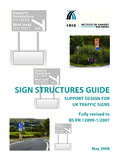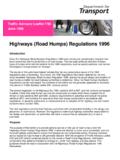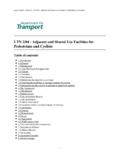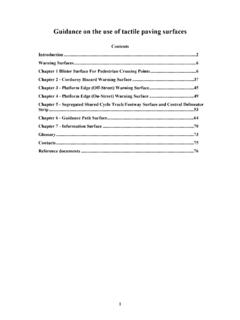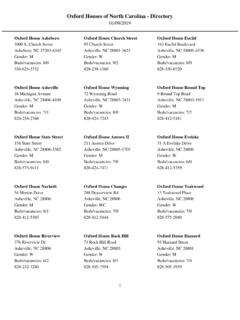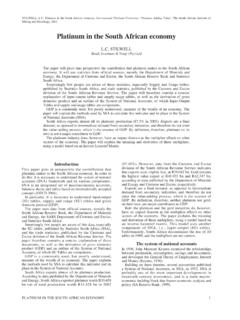Transcription of Passive Safety UK Guidelines for Specification and …
1 Passive Safety UK Guidelinesfor Specification and Use of Passively Safe Street Furnitureon the UK Road NetworkGuidelines 12/4/10 12:18 Page 1 Passive Safety UK GUIDELINES2 APRIL 2010 Published by Passive Safety UKin association with Traffic Engineering & Control April 12/4/10 12:18 Page 2 Passive Safety UK Guidelines APRIL 20103 Passive Safety UK s central objective is to promote safer roadsides. Passive Safety can greatly reducethe road toll on non-trunk roads where most of our road casualties now occur. We understand no-one in the UK has been killed or seriously injured hitting an item of passively safe street furnitureor in a related secondary accident where a passively safe item of street furniture breaks Guidelines are to assist Highway Authorities in employing Passive Safety to help make theirroads safer.
2 They make the case for Passive Safety , advise on how to employ passively safe street furni-ture and discuss targeting scarce resources to most benefit in Safety and economic terms. They also ex-plore measures to reduce casualties from hitting trees. Advice has been provided in the past for Trunkroads in TA89/04 and TA89/05 but these new Guidelines target local authority roads where most Killedand Serious Injured accidents any new development there will be concerns about risk. With Passive Safety this has centeredon the possibility of frangible posts hitting pedestrians or causing other secondary accidents. Whilstthis aspect is explored in these Guidelines , the real risk is from impacts with conventional street furni-ture and above all trees, as is so clearly demonstrated in the relevant road casualty statistics.
3 I would like to thank David Milne for his significant contribution to this PledgePassive Safety UKPassive Safety UK Guidelines for Specification and Use of Passively Safe Street Furniture on the UK Road Network Guidelines 12/4/10 12:18 Page 3 Passive Safety UK GUIDELINES4 APRIL 2010 EndorsementsIt should be a cause for concern that in 2007 nearly 600 people were killed or seriously injured in single vehicle collisionswith 'street furniture' Add in those from multiple vehicle collisions (where such 'street furniture' is not counted in thestatistics) and the scale of the problem we should be addressing becomes Guidelines now set out how ALL of us involved in the design, construction and operation of ALL roads in the UKshould be actively considering the use of passively safe street advice on the use of passively safe street furniture contained in the Design Manual for Roads and Bridges may, un-fortunately, have led many to have seen Passive Safety as a trunk road network issue only.
4 Yet, the majority of the single vehi-cle fatal accidents in the UK occur on local authority A and B class Highways Agency and a number of innovative local highway authorities have now established the worth of passivelysafe street furniture and their efforts should be current road Safety targets set by Government require a reduction of 40% in Killed and Seriously Injured casualties by2010 (set against an average for 1994-98) and in most Highway Authorities this is likely to be targets beyond 2010 are, quite rightly, to be as challenging to Highway Authority s and Passive Safety will be an es-sential element in any 'toolbox'.The IHE firmly supports the work done by Andrew Pledge and David Milne who are to be congratulated on their continu-ing efforts to establish a 'forgiving' infrastructureIHE fully support and commend this new guidance to its members and all local highway authorities.
5 Its adoption will playa significant part in establishing safer roadsides and in doing contribute to the reduction in the unacceptable cost, both emo-tionally and monetary, to our communities and SharpPresident, Institute of Highway EngineersThe UK continues to be a world leader in road Safety . Our casualty rates are among the lowest in Europe, and we have along history of developing and applying the latest techniques to improve the Safety of our roads. Local authorities andtheir partners play a vital part in making our roads as safe as they are. Around 90% of all accidentsoccur on local roads and the most successful authorities have reduced killed and seriously injured casualties by embracingnew ideas and implementing them on their the more we achieve the harder it will become to achieve more.
6 It has been demonstrated that whilst the concepts of forgiving roads and proactive Safety are forward thinking approaches they are successful approaches that contribute to min-imising the severity of injuries. These new Guidelines on Passive Safety are a welcome addition to a designer's documentationand one that contributes to the concepts previously Chartered Institution of Highways and Transportation, has for many years been seen by the profession as a leading ad-vocate of the importance of the delivery of effective Safety management on our public highways for all users. Through itsRoad Safety Panel, the CIHT is committed to delivering and disseminating Good Practice in the field of road Safety to theprofession and it is pleases to commend these Guidelines to Smart BSc C.
7 Eng FIHT MICE Director of Professional and Business Development,Chartered Institution of Highways and TransportationGuidelines 12/4/10 12:18 Page 4 Passive Safety UK Guidelines APRIL 20105 These Guidelines will be invaluable to the Road Safety Practitioner, particularly when designing schemes within ruralareas. The casualty statistics outlined in the Guidelines indicate that the majority of sites for locating passively safestreet furniture will be in the countryside. There will, however, be the occasional need in built up areas, where speeds(lawful or otherwise) are likely to be high. The philosophy of minimizing clutter and creating a forgiving environmentshould apply roadsides are key to the whole concept of rural Safety management.
8 Fundamentally, Engineers should firstly pose thequestion, is this sign really needed? If it is, then is it impossible for the feature to be located outside the so-called clearzone ? If the answer to both these questions is yes and speeds are likely to be in excess of 25mph, then Passive posts should beused. ( The Guidelines recommend that an Exception Report be produced to justify non-use, with reasoning.)The Guidelines will encourage the long-overdue debate, concerning ways of reducing the high involvement of roadsidetrees in the fatality figures. There is a fine line between wholesale destruction of our countryside with removal of trees and thealternative - a continuing loss of human life.
9 Approximately one death in every thirteen is as a result of hitting a tree, in a sin-gle vehicle loss of control accident (250 deaths and 1031 serious injuries in 2007 alone). Road Safety Education will play a keyrole in making drivers aware of the scale of the problem and hence addressing the concerns of the environmental lobby. Al-ternatively, publicising the problem may have the benefit of reducing the need for the cull. In any event, these Guidelinesoffer a structured way of evaluating and treating the is delighted to support the work and ethos of Passive Safety UK. The new comprehensive advice given in PassiveSafety UK Guidelines will make a valuable contribution to casualty reduction now and beyond J StilwellEur Ing Nick J Stilwell BSc CEng MICE MCIHT FIHE FAIRSORoad Safety Engineering and Sustainability Portfolio Holder for AIRSOG uidelines 12/4/10 12:18 Page 5 Passive Safety UK GUIDELINES6 APRIL 2010 ContentsChapter 2.
10 Prioritising roads for Passive Safety . Table 1 Prioritising Roads for the Specification of Passively Safe Street FurnitureChapter guidance on Passive Safety clear zones. Chapter EN12767:2007 Passive Safety of support structures for road equipment. Requirements, classification and test methods Chapter class recommendations for passively safe productsTable 2 Exit Speed Requirements for NE, LE and HE ratingsChapter 6. Specifying passively safe signposts to BS EN 12899 Table 3 Summary of Recommendations for use of EN 12767 Classifications taken from the proposed National AnnexChapter 7. Specifying passively safe lighting columns to BS EN 40 Chapter 8. Specifying passively safe signal polesChapter power supplies and electrical Safety for passively safe street and Sources of Further InformationGuidelines 12/4/10 12:18 Page 6 Passive Safety UK Guidelines APRIL 20107 CHAPTER 1: INTRODUCTION Guidelines provide advice for the adoption andselection of the appropriate type of passively safe sign-posts, lighting columns, traffic signal poles, bollards andother passively safe street furniture for all rural and urbanroads.

